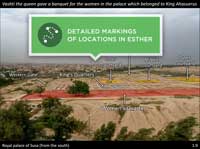Archaeologists have discovered an underground chamber in Nero’s Domus Aurea palace.
“Ancient workers used molten iron to repair Pompeii’s streets before the historic and devastating eruption of Mount Vesuvius in A.D. 79.”
Greek authorities have granted permission for the restoration of the interior of the Parthenon in Athens.
Turkish officials have discovered an ancient mosaic that was illegally excavated in Çanakkale.
“Ancient treasures pillaged from conflict zones in the Middle East are being offered for sale on Facebook, researchers say, including items that may have been looted by Islamic State militants.”
In light of ISIS’s plundering, researchers have attempted to quantity the market value of artifacts from a single site.
The Biblical History Center in LaGrange, Georgia, is seeking approval to build a replica of the Sea of Galilee.
The Minerva Center for the Relations between Israel and Aram in Biblical Times has announced the list of speakers for its 2019 conference “Between Israel, Aram and Phoenicia: Archaeological and Historical Perspectives.”
BibleX has posted a mini-review of the Photo Companion to Daniel.
HT: Ted Weis, Agade, A.D. Riddle

